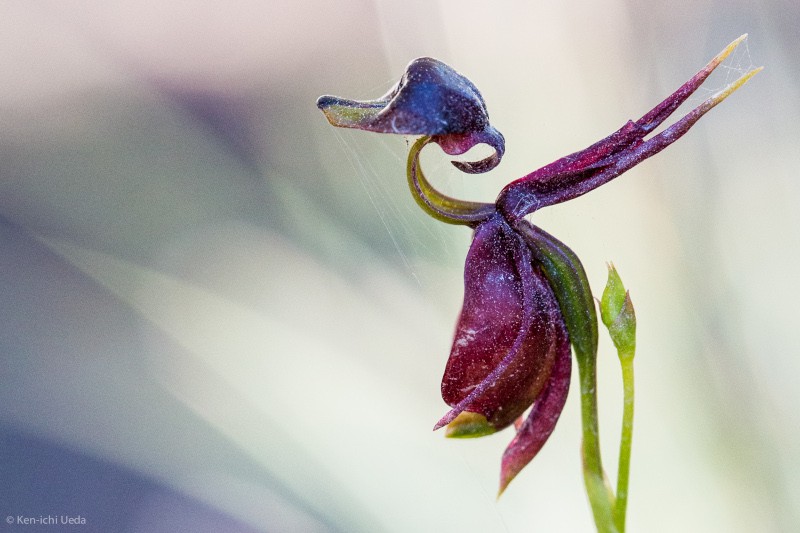Flying Duck Orchid Facts
- This amazing flower most frequently goes by the name of the Flying Duck Orchid. It also goes by the alternate common name of the large duck orchid. Both names clearly derive from its physical shape, considered by some people to closely resemble a duck taking flight.
- Its official scientific name, though, remains that of the relatively easy to pronounce term of Caleana major. The well-respected Scottish botanist, Robert Brown made the first recorded recognition of it as a separate and distinct species. This noteworthy deed occurred in 1810.
- That researcher initially collected the sample that led to the original identification of the flora in 1803. That accomplishment appeared in his work, entitled Prodromus Florae Novae Hollandiae et Insulae Van Diemen. He named it in honor of a fellow botanist, George Caley.
- Fortunately, its numbers appear to be both sufficient and stable, at least for the moment. That pleasant state holds true throughout the entirety of its natural range. It’s now become a popular addition to gardens around the world, as well, due to its distinctive appearance.
- For these reasons, the IUCN does not currently have any listing for it on the organizations’ Red List of Threatened Species. In its natural range, though, it does face potential threats to its existence. These include habitat loss due to human expansion, and of course, climate change.
Related Articles
Flying Duck Orchid Physical Description
The remarkable Flying Duck Orchid certainly merits its due measure of appreciation. It does not do so, however, due to sheer phsycial size. That’s because this variety of orchid, while fascinating, isn’t a large member of the genus. In point of fact, it’s fairly small, compared to some of its kin.
The plants’ size also varies significantly between individuals. Surprisingly, it additionally seems to do so fully independent of local environmental conditions. Vertical height ranges from around 8 – 20 in (20.3 – 50.8 cm). Specimens from both ends of this range sometimes appear beside each other.
The single stalk this marvel produces develops as relatively thin, and typically shows a pale green in color. From the base of this feature, a single leaf grows. This foliage develops as quite narrow and lance-shaped, and displays a dark reddish color. It also averages 2 – 5 in (5 – 12.7 cm) in length.
Despite its seeming fragility, the thin stalk usually supports up to an impressive total of 5 of the intriguing flowers. These average 0.8 – 1 in (2 – 2.5 cm) in length, and show a reddish-brown hue. Sometimes, however, these blooms appear as a greenish shade, along with numerous dark spots.
It’s the overall combined shape of its parts that garner the Flying Duck Orchid its distinctive common name, though. The remarkable structure of the pant that serves to attract insects, called the labellum, strongly resembles the head of a duck. Atop the stem, it seems to be poised for flight.
- Kingdom: Plantae
- Phylum: Tracheophyta
- Class: Angiosperm
- Order: Asparagales
- Family: Orchidaceae
- Genus: Caleana
- Species: C. major
Flying Duck Orchid Distribution, Habitat, and Ecology
Unfortunately, the stunning Flying Duck Orchid evolved as native to an extremely limited section of the surface of the globe. Like many other fascinating plants, that’s the region now known as Australia. Even there, though, this wonder of nature only appears in a few regions of similar nature.
More specifically, this botanical beauty only grows in parts of New South Wales, Queensland, Victoria, South Australia, and the island state of Tasmania. Even within these regions, however, it possesses highly specific habitat requirements. This characteristic also severely limits its expansion.
The vast majority of observed specimens develop in areas consisting of either swampy or coastal shrubland, eucalyptus woodlands, or heathland. It also typically appears in proximity to the coastline. A small percentage of individual specimens do sometimes appear at higher altitudes.
Like most flowering plants, it accomplishes its pollination via the actions of insects. Unlike most similar plants, though, bees do not constitute the principal agents of this process. This orchid actually evolved to primarily utilize sawflies for this action, and mainly males, at that.
The astounding Flying Duck Orchid tricks the males into thinking that the plant is a female of their species. When they land, they find themselves forced by the design of the structure to move between the labellum and surrounding columns. As they do, they release pollen in their struggles.
It does not simply remain passive throughout this process, however. In a truly amazing evolutionary develoment, the plant actually moves to facilitate the process. As the visiting sawfly moves, the neck-like structure actually snaps shut, and with relatively surprising speed, trapping it!
Species Sharing Its Range
Check out our other articles on 4 Refreshingly Remarkable Rivers, Bonnethead Shark, Oribi, Postojna Cave, Mormon Metalmark, Socotra Dragon Tree, Hyacinth Macaw, Anegada groud iguana

